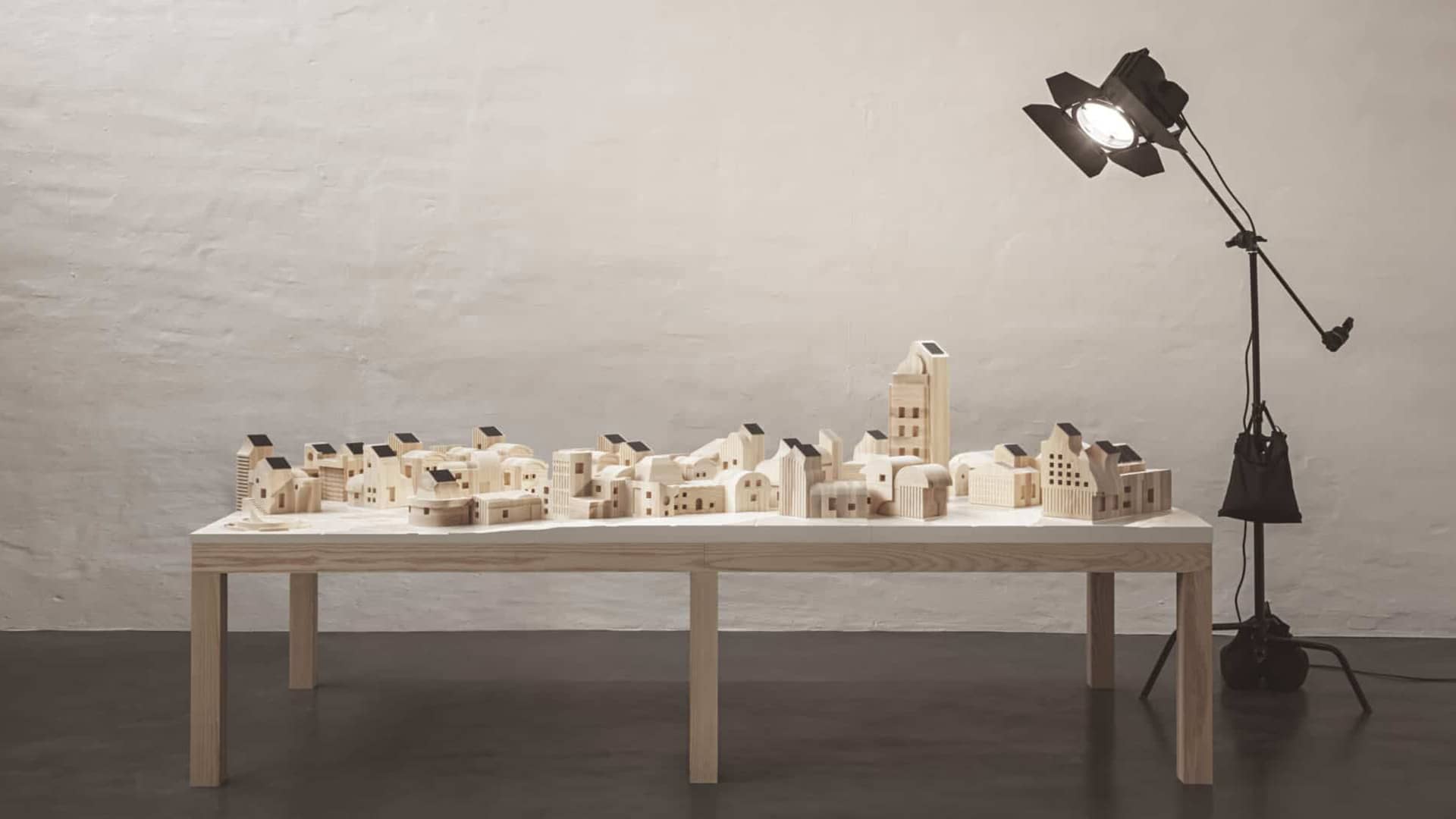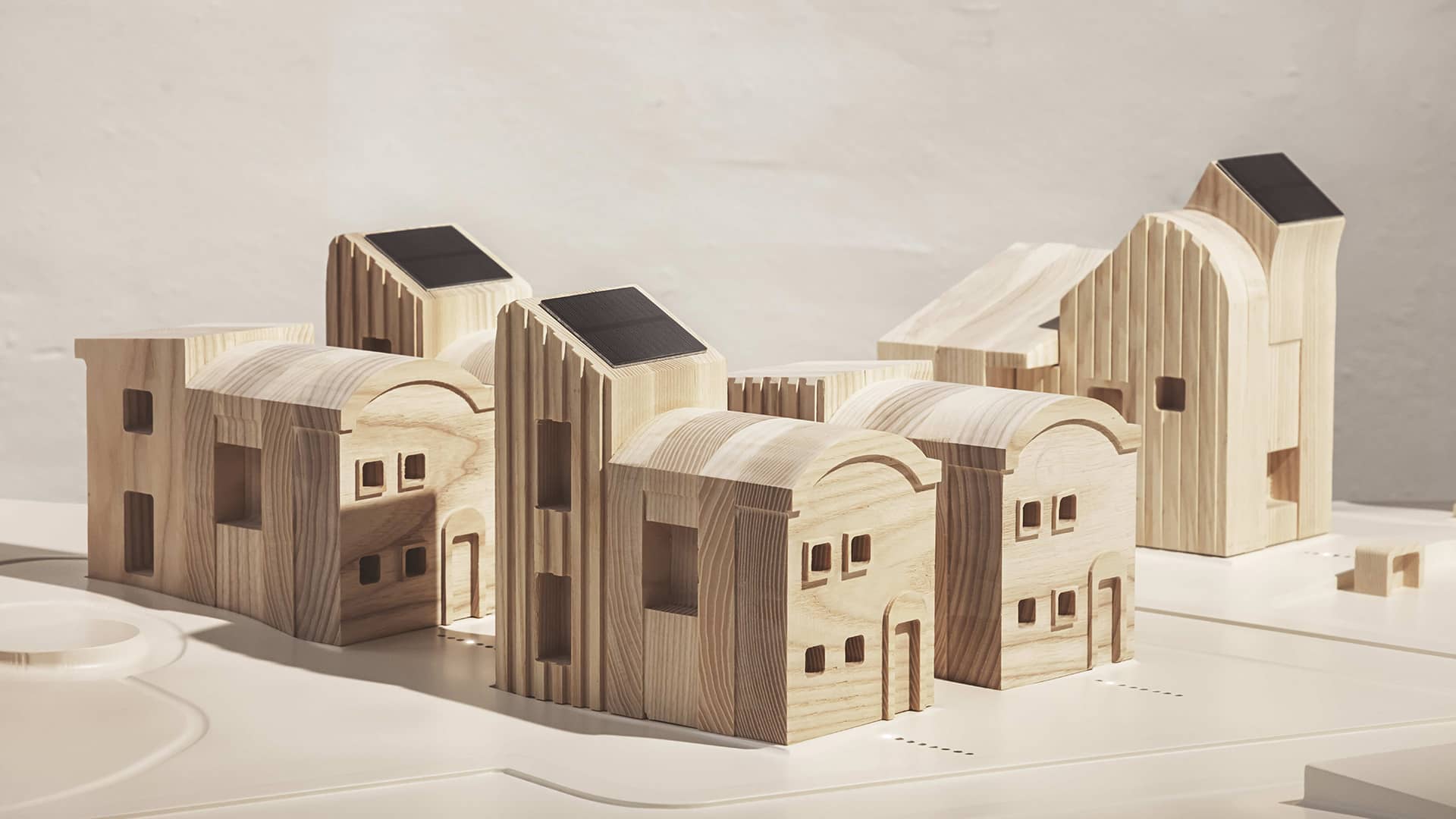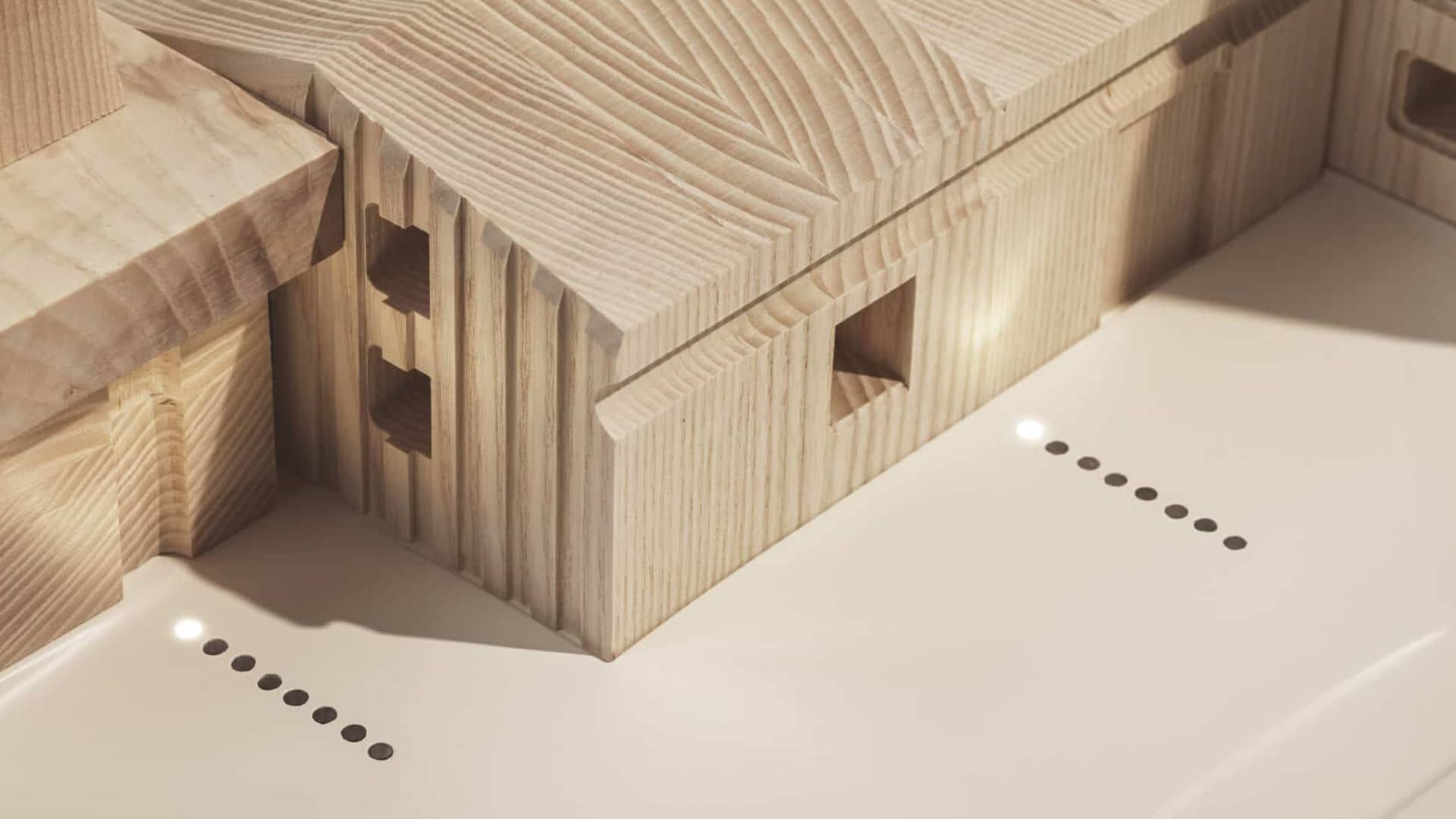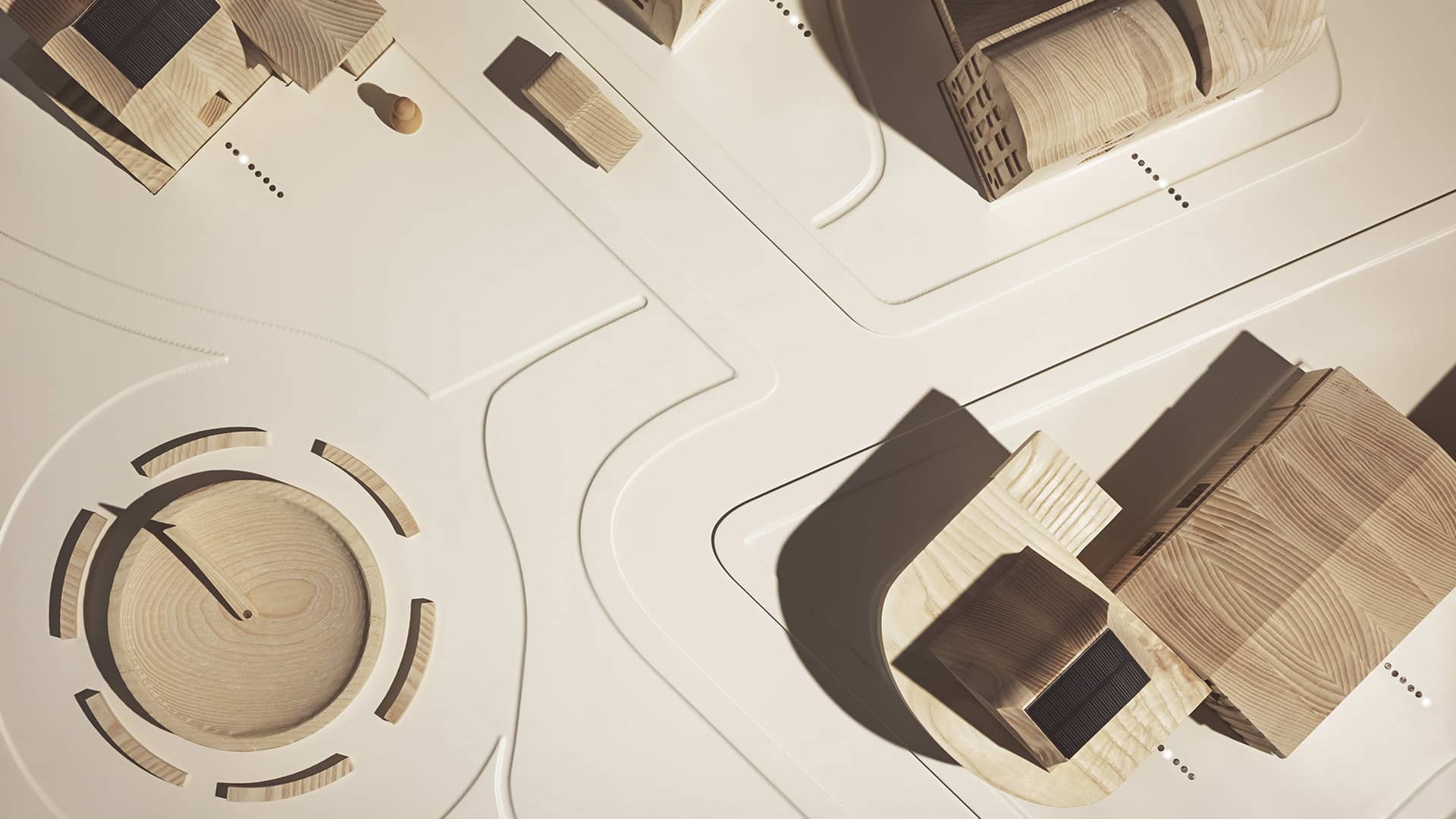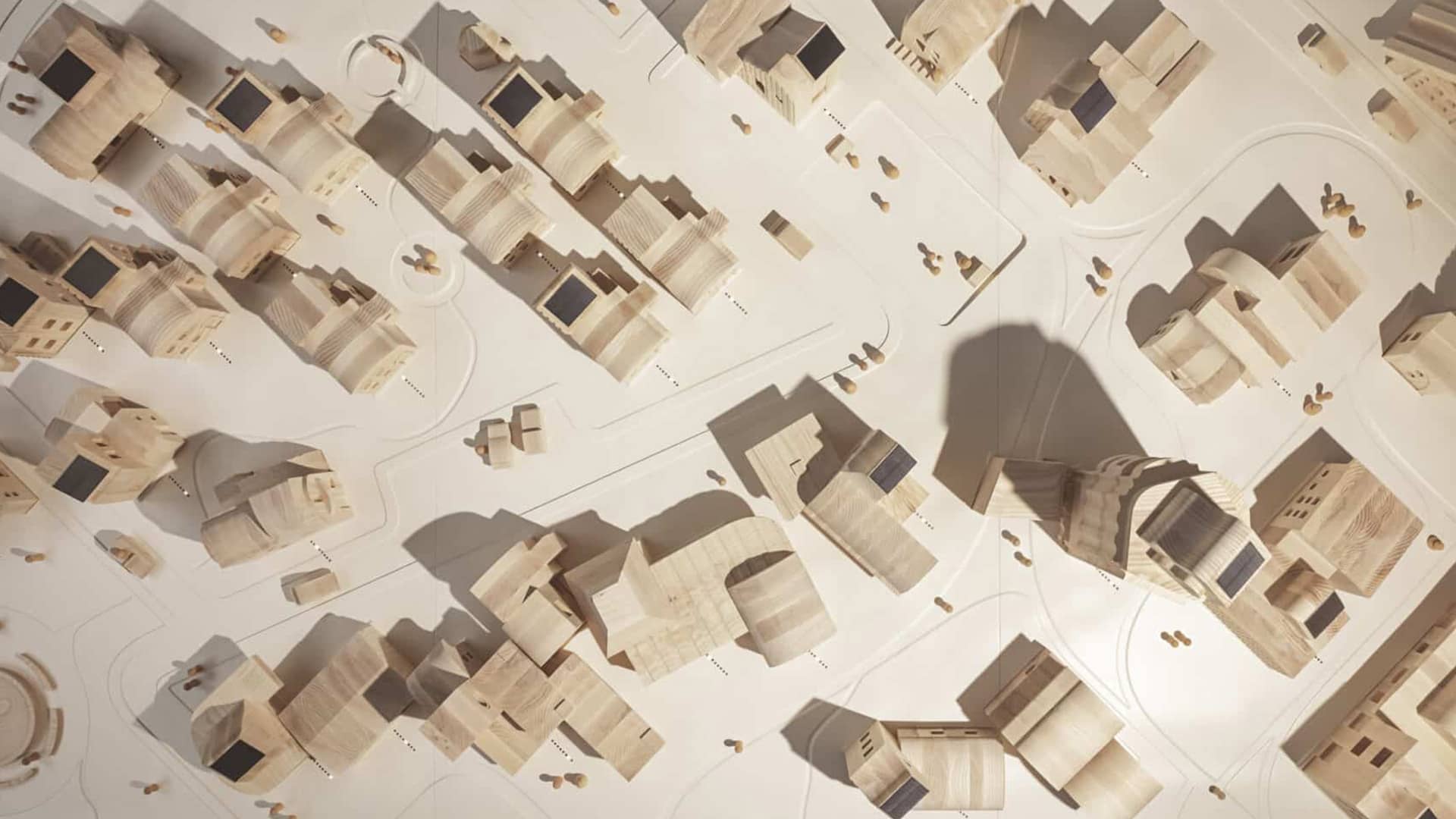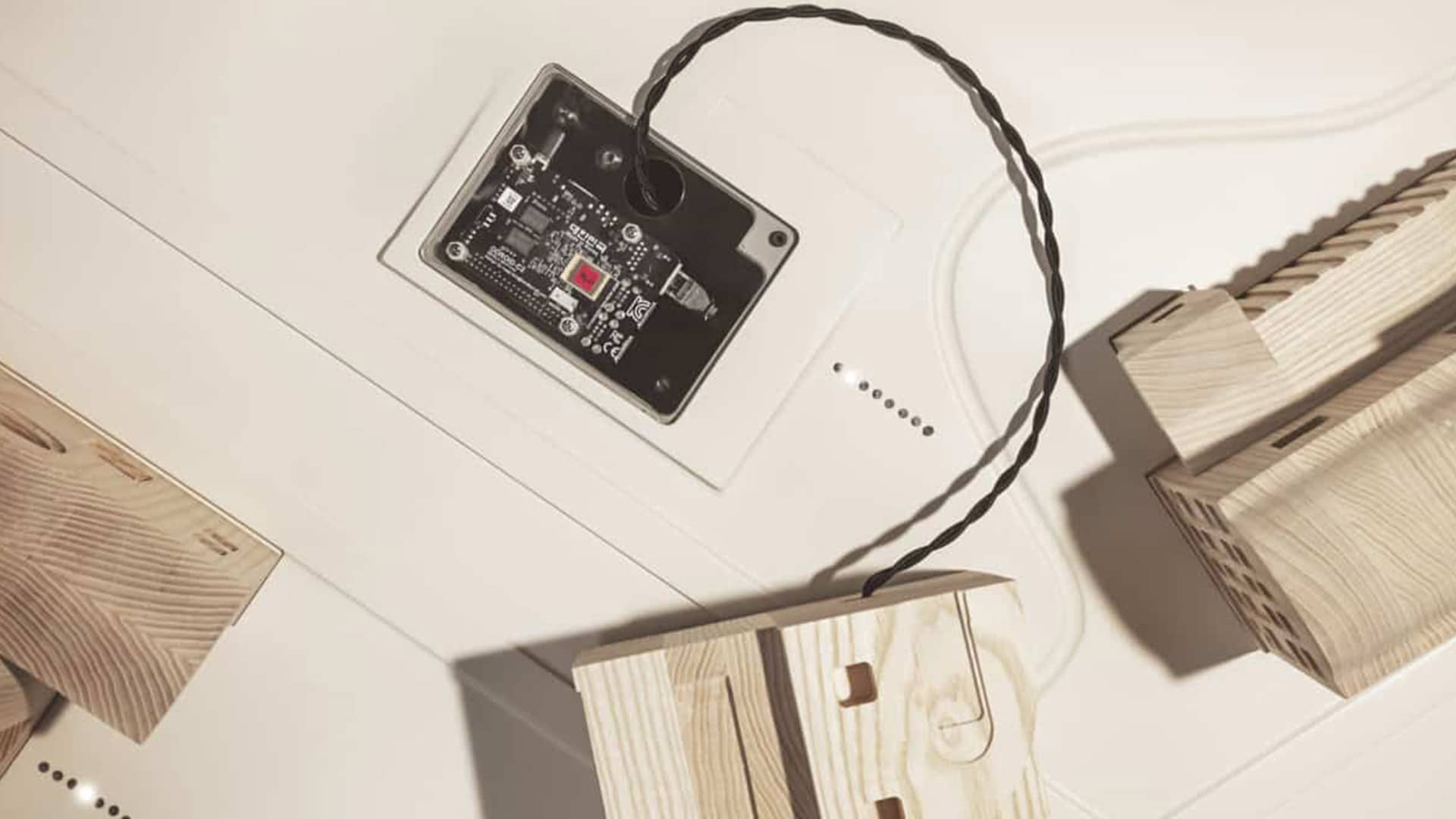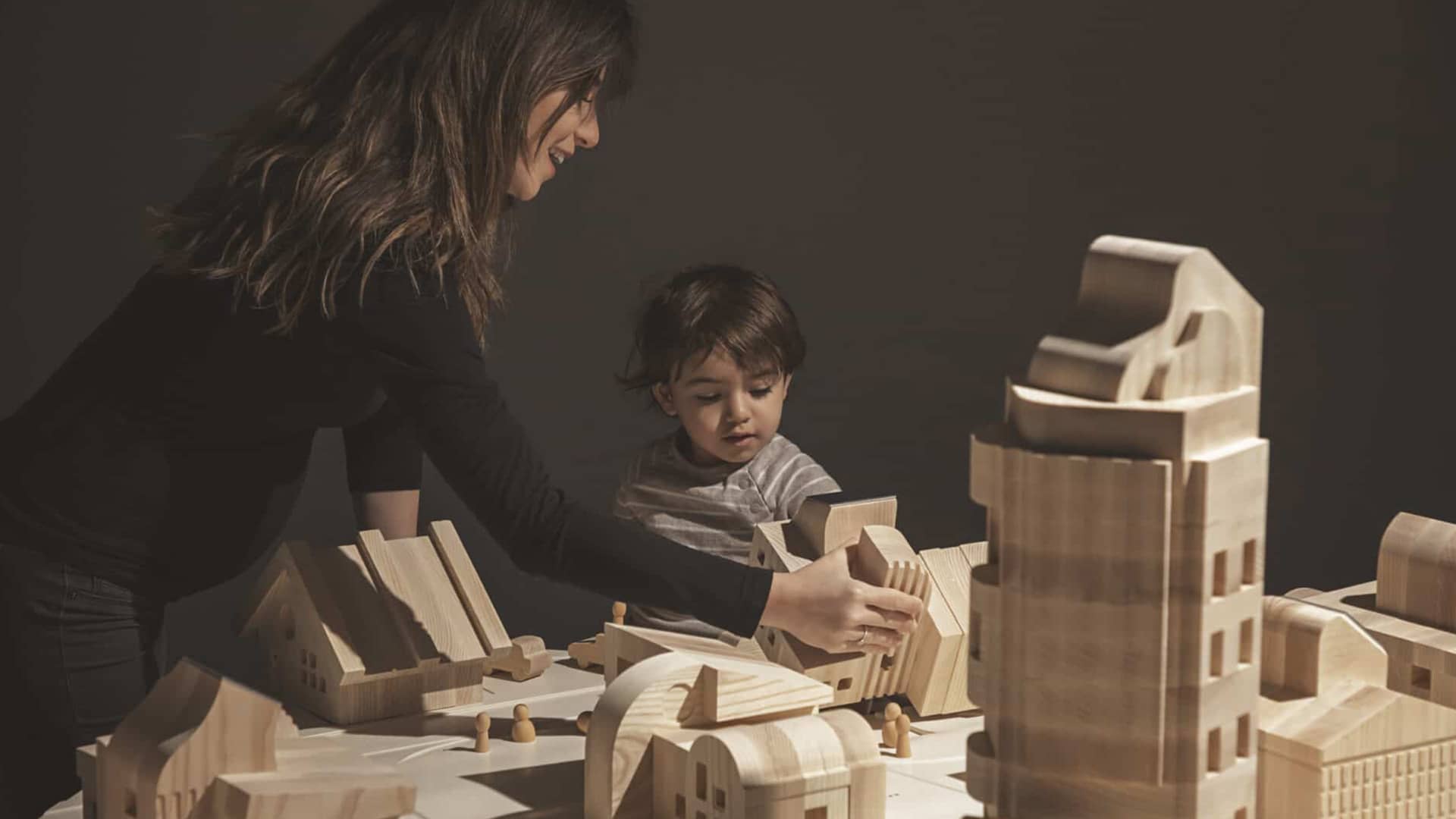SPACE10 presents SolarVille - a playful research project which reimagines our energy system in the pursuit of democratising access to clean energy.
SolarVille is an ambitious yet fully realisable vision for the future. More specifically, it’s a working prototype of a miniature neighbourhood completely powered by solar energy. Built to a 1:50 scale, some households generate their own renewable energy using solar panels, while others automatically purchase excess electricity directly from the producer using blockchain technology. The result is a model of a self-sufficient, community-driven microgrid where people trade renewable, affordable energy from one another according to their individual needs. Alongside the project, we’ve also released a report called ‘A Brighter Tomorrow’, which lends more insights into the research behind SolarVille. More importantly, it makes the case for solar power becoming the viable, sustainable source of energy we need to turn to if we want to mitigate the effects of climate change.
The partners
SPACE10, Blockchain Labs for Open Collaboration (BLOC), WeMoveIdeas India, Blocktech, Temporal, SachsNottveit.
The vision
Around 2 billion people in the world still have little to no access to electricity, with 860 million people living with absolutely no access at all. It’s an almost impossibly expensive task to reach these people with the centralised energy networks we have in place today, often because they’re too slow and economically adequate to reach those locked in energy poverty. SolarVille aims to showcase that, when combined, technologies such as solar panels, micro-grids and blockchain open new opportunities for off-grid systems—allowing people to leapfrog traditional grid electricity.
The installation
SolarVille takes shape as a miniature, wooden village designed by architecture practice SachsNottveit. Some of the wooden households have solar panels on their roofs that capture artificial sun rays extended above the installation. As a viewer, you can see the whole flow of energy through small LED lights embedded in the model that showcases electricity traded within the community in real-time. For the curious minds, a hatch on the side of the table displays BLOC’s underlying blockchain technology at work. As a result, the model enables you to observe a functioning network of blockchain-traded energy and interact with an artificial sun to see its effect on the network in real-time.
How does it work?
We’ve followed these steps to make SolarVille a working prototype—but theoretically, they could be replicated in real life, too.
Step 1: Add sunshine
The first step is sunshine. Luckily, it’s free and by far the most plentiful energy source available to humankind. The planet receives more solar energy in a week than all the energy known to exist in the planet’s recoverable reserves of oil, gas and coal combined.
Step 2: Install solar panels
The next step is installing solar panels to capture the energy from the sun. Once installed with an inverter, they deliver free, renewable energy in return for the initial investment. Solar power is already cost-competitive in several areas of the world and we can only expect a continuous fall in prices.
Step 3: Install a storage system
The sun doesn’t always shine and the wind doesn’t always blow, so we need to store renewable energy to ensure a reliable flow of power whenever needed. After a century of stagnation, batteries have started to rapidly develop—leading to much better storage and much cheaper prices, which makes batteries commercially viable. In addition to these promising improvements, breakthroughs in storing energy using other techniques are also making notable progress. One example is turning solar energy into hydrogen which soon could prove to be another viable option.
Step 4: Distribute the energy
Step 4 is to connect and distribute the energy directly between people in the community. Good old wires can easily connect households in the local neighbourhood, creating a standalone micro-grid.
Step 5: Regulate the system with blockchain technology
Blockchain technology could be the 5th step in creating a secure and decentralised trading platform for the widespread deployment of renewable, distributed energy resources. Blockchain technology stores energy transactions and lets people trade directly on a peer-to-peer basis. The distributed ledger technology is used to log and manage the energy flow—verifying and recording transactions, and self-executing when certain conditions are met. Not only does this reduce transaction costs: it increases transparency and security, and lowers the barrier of entry for new actors in the system. The cutting out of intermediaries is the final step towards a truly distributed energy system that could potentially empower people with affordable, clean energy.
Step 6: Assemble your off-the-grid energy system
All of these steps are possible to take today. SolarVille demonstrates this. The biggest selling point? When you buy energy from your community, the money stays in the community. It’s power to the people in the purest form.
So why isn’t SolarVille a reality everywhere?
If solar power is cheaper than any other source of new power in most parts of the world, then why isn’t all of our electricity coming from solar?
Huge amounts of coal and gas-generating capacity are already installed. These power plants will continue to produce energy as long as they make just enough money for their managers to keep the doors open. In many countries, total electricity demand is falling and it is more difficult to invest in solar if power needs are met by existing plants. Storage is still expensive. Without storage, solar is both intermittent and, in many places, unreliable. In order to ensure round-the-clock electricity, you have to factor in the cost of a storage device, which might double the cost of night-time power in a sunny country.
A brighter tomorrow, indeed
Despite the obstacles referred to above, solar’s future is bright. Solar energy is not a fuel that can be used up, but a technology that is constantly being developed. Because of that, we can expect a continuous fall in prices associated with relying on solar energy for our electricity needs. Ultimately, that will make clean energy cheaper and more accessible in the indefinite future.
SPACE10 presents SolarVille - a playful research project which reimagines our energy system in the pursuit of democratising access to clean energy.
SolarVille is an ambitious yet fully realisable vision for the future. More specifically, it’s a working prototype of a miniature neighbourhood completely powered by solar energy. Built to a 1:50 scale, some households generate their own renewable energy using solar panels, while others automatically purchase excess electricity directly from the producer using blockchain technology. The result is a model of a self-sufficient, community-driven microgrid where people trade renewable, affordable energy from one another according to their individual needs. Alongside the project, we’ve also released a report called ‘A Brighter Tomorrow’, which lends more insights into the research behind SolarVille. More importantly, it makes the case for solar power becoming the viable, sustainable source of energy we need to turn to if we want to mitigate the effects of climate change.
The partners
SPACE10, Blockchain Labs for Open Collaboration (BLOC), WeMoveIdeas India, Blocktech, Temporal, SachsNottveit.
The vision
Around 2 billion people in the world still have little to no access to electricity, with 860 million people living with absolutely no access at all. It’s an almost impossibly expensive task to reach these people with the centralised energy networks we have in place today, often because they’re too slow and economically adequate to reach those locked in energy poverty. SolarVille aims to showcase that, when combined, technologies such as solar panels, micro-grids and blockchain open new opportunities for off-grid systems—allowing people to leapfrog traditional grid electricity.
The installation
SolarVille takes shape as a miniature, wooden village designed by architecture practice SachsNottveit. Some of the wooden households have solar panels on their roofs that capture artificial sun rays extended above the installation. As a viewer, you can see the whole flow of energy through small LED lights embedded in the model that showcases electricity traded within the community in real-time. For the curious minds, a hatch on the side of the table displays BLOC’s underlying blockchain technology at work. As a result, the model enables you to observe a functioning network of blockchain-traded energy and interact with an artificial sun to see its effect on the network in real-time.
How does it work?
We’ve followed these steps to make SolarVille a working prototype—but theoretically, they could be replicated in real life, too.
Step 1: Add sunshine
The first step is sunshine. Luckily, it’s free and by far the most plentiful energy source available to humankind. The planet receives more solar energy in a week than all the energy known to exist in the planet’s recoverable reserves of oil, gas and coal combined.
Step 2: Install solar panels
The next step is installing solar panels to capture the energy from the sun. Once installed with an inverter, they deliver free, renewable energy in return for the initial investment. Solar power is already cost-competitive in several areas of the world and we can only expect a continuous fall in prices.
Step 3: Install a storage system
The sun doesn’t always shine and the wind doesn’t always blow, so we need to store renewable energy to ensure a reliable flow of power whenever needed. After a century of stagnation, batteries have started to rapidly develop—leading to much better storage and much cheaper prices, which makes batteries commercially viable. In addition to these promising improvements, breakthroughs in storing energy using other techniques are also making notable progress. One example is turning solar energy into hydrogen which soon could prove to be another viable option.
Step 4: Distribute the energy
Step 4 is to connect and distribute the energy directly between people in the community. Good old wires can easily connect households in the local neighbourhood, creating a standalone micro-grid.
Step 5: Regulate the system with blockchain technology
Blockchain technology could be the 5th step in creating a secure and decentralised trading platform for the widespread deployment of renewable, distributed energy resources. Blockchain technology stores energy transactions and lets people trade directly on a peer-to-peer basis. The distributed ledger technology is used to log and manage the energy flow—verifying and recording transactions, and self-executing when certain conditions are met. Not only does this reduce transaction costs: it increases transparency and security, and lowers the barrier of entry for new actors in the system. The cutting out of intermediaries is the final step towards a truly distributed energy system that could potentially empower people with affordable, clean energy.
Step 6: Assemble your off-the-grid energy system
All of these steps are possible to take today. SolarVille demonstrates this. The biggest selling point? When you buy energy from your community, the money stays in the community. It’s power to the people in the purest form.
So why isn’t SolarVille a reality everywhere?
If solar power is cheaper than any other source of new power in most parts of the world, then why isn’t all of our electricity coming from solar?
Huge amounts of coal and gas-generating capacity are already installed. These power plants will continue to produce energy as long as they make just enough money for their managers to keep the doors open. In many countries, total electricity demand is falling and it is more difficult to invest in solar if power needs are met by existing plants. Storage is still expensive. Without storage, solar is both intermittent and, in many places, unreliable. In order to ensure round-the-clock electricity, you have to factor in the cost of a storage device, which might double the cost of night-time power in a sunny country.
A brighter tomorrow, indeed
Despite the obstacles referred to above, solar’s future is bright. Solar energy is not a fuel that can be used up, but a technology that is constantly being developed. Because of that, we can expect a continuous fall in prices associated with relying on solar energy for our electricity needs. Ultimately, that will make clean energy cheaper and more accessible in the indefinite future.
SPACE10 presents SolarVille - a playful research project which reimagines our energy system in the pursuit of democratising access to clean energy.
SolarVille is an ambitious yet fully realisable vision for the future. More specifically, it’s a working prototype of a miniature neighbourhood completely powered by solar energy. Built to a 1:50 scale, some households generate their own renewable energy using solar panels, while others automatically purchase excess electricity directly from the producer using blockchain technology. The result is a model of a self-sufficient, community-driven microgrid where people trade renewable, affordable energy from one another according to their individual needs. Alongside the project, we’ve also released a report called ‘A Brighter Tomorrow’, which lends more insights into the research behind SolarVille. More importantly, it makes the case for solar power becoming the viable, sustainable source of energy we need to turn to if we want to mitigate the effects of climate change.
The partners
SPACE10, Blockchain Labs for Open Collaboration (BLOC), WeMoveIdeas India, Blocktech, Temporal, SachsNottveit.
The vision
Around 2 billion people in the world still have little to no access to electricity, with 860 million people living with absolutely no access at all. It’s an almost impossibly expensive task to reach these people with the centralised energy networks we have in place today, often because they’re too slow and economically adequate to reach those locked in energy poverty. SolarVille aims to showcase that, when combined, technologies such as solar panels, micro-grids and blockchain open new opportunities for off-grid systems—allowing people to leapfrog traditional grid electricity.
The installation
SolarVille takes shape as a miniature, wooden village designed by architecture practice SachsNottveit. Some of the wooden households have solar panels on their roofs that capture artificial sun rays extended above the installation. As a viewer, you can see the whole flow of energy through small LED lights embedded in the model that showcases electricity traded within the community in real-time. For the curious minds, a hatch on the side of the table displays BLOC’s underlying blockchain technology at work. As a result, the model enables you to observe a functioning network of blockchain-traded energy and interact with an artificial sun to see its effect on the network in real-time.
How does it work?
We’ve followed these steps to make SolarVille a working prototype—but theoretically, they could be replicated in real life, too.
Step 1: Add sunshine
The first step is sunshine. Luckily, it’s free and by far the most plentiful energy source available to humankind. The planet receives more solar energy in a week than all the energy known to exist in the planet’s recoverable reserves of oil, gas and coal combined.
Step 2: Install solar panels
The next step is installing solar panels to capture the energy from the sun. Once installed with an inverter, they deliver free, renewable energy in return for the initial investment. Solar power is already cost-competitive in several areas of the world and we can only expect a continuous fall in prices.
Step 3: Install a storage system
The sun doesn’t always shine and the wind doesn’t always blow, so we need to store renewable energy to ensure a reliable flow of power whenever needed. After a century of stagnation, batteries have started to rapidly develop—leading to much better storage and much cheaper prices, which makes batteries commercially viable. In addition to these promising improvements, breakthroughs in storing energy using other techniques are also making notable progress. One example is turning solar energy into hydrogen which soon could prove to be another viable option.
Step 4: Distribute the energy
Step 4 is to connect and distribute the energy directly between people in the community. Good old wires can easily connect households in the local neighbourhood, creating a standalone micro-grid.
Step 5: Regulate the system with blockchain technology
Blockchain technology could be the 5th step in creating a secure and decentralised trading platform for the widespread deployment of renewable, distributed energy resources. Blockchain technology stores energy transactions and lets people trade directly on a peer-to-peer basis. The distributed ledger technology is used to log and manage the energy flow—verifying and recording transactions, and self-executing when certain conditions are met. Not only does this reduce transaction costs: it increases transparency and security, and lowers the barrier of entry for new actors in the system. The cutting out of intermediaries is the final step towards a truly distributed energy system that could potentially empower people with affordable, clean energy.
Step 6: Assemble your off-the-grid energy system
All of these steps are possible to take today. SolarVille demonstrates this. The biggest selling point? When you buy energy from your community, the money stays in the community. It’s power to the people in the purest form.
So why isn’t SolarVille a reality everywhere?
If solar power is cheaper than any other source of new power in most parts of the world, then why isn’t all of our electricity coming from solar?
Huge amounts of coal and gas-generating capacity are already installed. These power plants will continue to produce energy as long as they make just enough money for their managers to keep the doors open. In many countries, total electricity demand is falling and it is more difficult to invest in solar if power needs are met by existing plants. Storage is still expensive. Without storage, solar is both intermittent and, in many places, unreliable. In order to ensure round-the-clock electricity, you have to factor in the cost of a storage device, which might double the cost of night-time power in a sunny country.
A brighter tomorrow, indeed
Despite the obstacles referred to above, solar’s future is bright. Solar energy is not a fuel that can be used up, but a technology that is constantly being developed. Because of that, we can expect a continuous fall in prices associated with relying on solar energy for our electricity needs. Ultimately, that will make clean energy cheaper and more accessible in the indefinite future.







 Sign in with email
Sign in with email


